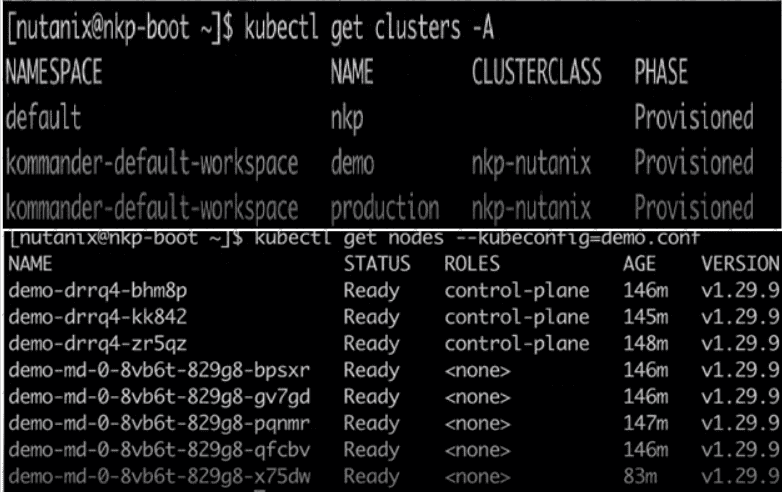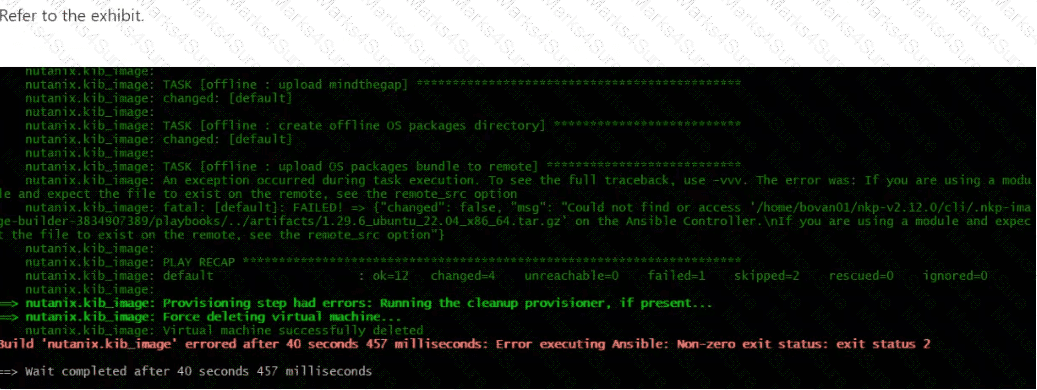A company uses an Artifactory private registry for development. The NKP deployment must use this private registry since the Security Administrator has the firewall configured to reject connections to public container registries. The first task is to push the NKP bundle to this private registry.
What options should be used to push the NKP bundle to this private registry?
A Platform Engineer is deploying an NKP workload cluster using the nkp create cluster vsphere command. The cluster will be utilized by the company’s code-green team and the engineer has already created a code-green NKP workspace on the NKP management cluster.
After issuing the deploy command, the engineer monitored the build using the nkp describe cluster command and confirmed it completed successfully. However, a few hours later, after logging into the NKP UI, the engineer checked the code-green NKP workspace and saw that the NKP workload cluster was not there.
What is the likely reason the NKP workload cluster is not in the code-green NKP workspace?
A Platform Engineer has a requirement for backup and recovery and would like to leverage an Out-Of-The-Box solution distributed with NKP. What is the backup and recovery solution distributed for NKP?
A Platform Engineer is attaching existing Kubernetes clusters to NKP, but some of them have network restrictions, so there is a need to use Secure Tunnel. The Platform Engineer needs to ask the Security Engineer to modify the firewall rules.
What must the firewall rules allow on the attached cluster network?

The cluster arca will host a new application that needs to add more workers. The company cannot get more NKP licenses, so it has decided to delete the demo cluster and add the required workers to the arca cluster. How should the engineer delete the demo cluster from this UI?
In an effort to control cloud cost consumption, auto-scale is configured to meet demands as needed.
What is the behavior for when nodes are scaled down?
After a finished project, three Kubernetes clusters within a workspace were deleted, so the workspace is empty. Now a Platform Engineer needs to delete the workspace. How should the engineer delete the workspace in NKP?
A Platform Engineer is attempting to delete an attached cluster from the NKP UI, but it is stuck in a 'deleting' state and does not get removed. How can the engineer resolve this attempt to detach the cluster so that it is removed from the UI and no longer managed by NKP?
NKP cluster nodes require a disk for some of its deployed components, outside of an application’s persistent volume requirements. What are these components and where are they deployed?
Refer to the exhibits.
A Cloud Administrator had provisioned a Kubernetes cluster named demo that is no longer actively being used. A Quick review from the Systems Engineer confirms that the following VMs are part of the demo Kubernetes cluster

How should the demo cluster be properly deleted?
A Platform Engineer wants to deploy a custom OS image for multiple NKP clusters for Nutanix AHV and AWS. Which two tools come bundled to facilitate creating and placing a custom image into the respective image repository?
An administrator has experienced issues with an NKP-managed workload cluster and has been tasked with deploying NKP Insights in order to:
Resolve common anomalies
Check security issues
Verify whether workloads follow best practicesUpon trying to enable NKP Insights, the cluster that needs to be chosen is grayed out.Which missing prerequisite should be enabled?
A development team has decided to implement an efficient logging system and use AWS S3 as storage to manage large volumes of logs in a scalable way.
The team followed these steps:
Set the WORKSPACE_NAMESPACE variable to the namespace copied in the previous step.
Created a config that overrode ConfigMap to update the storage configuration.
Updated the grafana-loki AppDeployment to apply the configuration override.However the implementation failed.What should the team do to be able to manage log storage in AWS?
A company has enabled auto-scaling within an NKP cluster. What is the behavior for auto-scaling?
A Platform Engineer is deploying a new Kubernetes application in Amazon Web Services (AWS) Elastic Container Service for Kubernetes (EKS) and Azure Kubernetes Service (AKS). The engineer’s team has decided to use a custom image instead of the default images provided by AWS or Azure for their clusters. What functionality will the engineer lose in both AWS EKS and Azure AKS by choosing to use a custom image?
A Platform Engineer needs to do an air-gapped installation of NKP. This environment needs to run without Internet access and be fully operational, including updates. Docker has been installed, and the NKP bundle exists on a bastion host. What is the first command that the engineer must run to begin the process?
A Platform Engineer for an organization needs to deploy NKP into AWS while using custom credentials for authenticating. Which flag should the engineer use when starting to bootstrap the cluster installation?
To keep an NKP cluster and applications healthy and drive productivity forward, a Platform Engineer needs to stay informed of all events occurring within the cluster. What component of kube-prometheus-stack will help the engineer to stay informed of these events in NKP?
An ecommerce company decides to apply an autoscaling configuration in its NKP cluster due to the fact that on holidays, they experience service drops due to a huge increase of simultaneous traffic.
Which statement best describes the configuration shown in the exhibit?

A Platform Engineer is preparing to deploy a new NKP cluster on Nutanix infrastructure into an air-gapped environment. As part of the preparation process, the engineer is supplying a Ubuntu 22.04 instance to be used for NKP cluster nodes that conforms to the corporate OS image hardening standards. However, during the NIB preparation process, the error shown in the exhibit is received.
What is the likely reason the NIB preparation attempt has failed?
A company is required by NIST to follow FIPS guidelines for compliance.
What is the first step for enabling FIPS in NKP?
A Platform Engineer is preparing an AWS instance using KIB for becoming an NKP cluster node. During the process, the source AMI is successfully cloned, and multiple preparation steps have occurred against the cloned AMI, such as gathering OS-release facts and uploading image bundles to it. However, the process encounters an error and ultimately fails. What is one troubleshooting step the engineer can perform that may help identify the root cause of the issue?
There is a private registry for the NKP deployment and the company has an NKP Ultimate license. A Platform Engineer is using the Podman tool and is already logged in. Now, the engineer needs to send the private registry with the NKP Catalog Applications.
What command should the engineer use?
A Platform Engineer works for a service provider and needs to establish access and authentication for multiple clients into an NKP cluster. Each client has their own LDAP source that should be used for authentication into the cluster.
How would this be accomplished?

An administrator is provisioning an NKP cluster. After the VM creation task, the error shown in the exhibit is produced.
What could be the reason?
A Cloud Engineer manages an NKP environment and is preparing a machine image to become an NKP cluster node.
Which statement is regarding the default node preparation process?